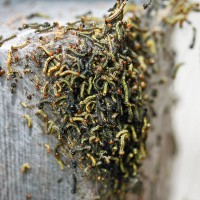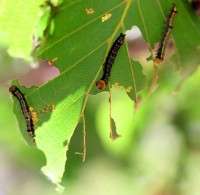
The California oak caterpillar (Phryganidia californica) and California oak moth is a native insect of coastal California. When heavy outbreaks occur, they voraciously feed upon the leaves of our native Coast Live Oak and also some other deciduous trees. The tan brown adult moths are commonly seen in the late afternoons as they hover around infested trees. They have only one goal which is to mate and lay eggs for the next generation of oak worm caterpillars. The moths themselves do not feed on the leaves. Extreme oakworm outbreaks occur approximately every 8-10 years. In the most extreme years, such as the one we experienced in 2007-08, 2022-2023, the infestation may lead to severe oak defoliation. During these outbreaks caterpillars are often seen suspended from silk strands, dropping to the ground, and congregating on fence posts, mail boxes, and other available platforms.
Healthy oaks usually recover from these defoliation events. Age, condition of trees, as well as human caused impacts must be considered. Oaks that are simultaneously subjected to stresses caused by landscape or home construction, drought, soil compaction, root severance, or pathogen infections (i.e. Sudden Oak Death Syndrome or oak root fungus) may be more seriously affected by oakworm defoliation.
Our experience indicates that each California oak caterpillar outbreak usually lasts for two years.
Tree Solutions does not agree with blanket statements that say this is a native pest on native trees and no action is needed. We acknowledge that there is a symbiotic relationship and in natural undisturbed settings, control is not usually warranted. However, in urban environments, we believe that each tree must be individually considered. Growing environment conditions vary and tree health is often compromised in the urban environment. Many trees are stressed, and stressed trees require action.
Early signs are difficult to detect. Tree Solutions recommends monitoring for oak caterpillars by a certified arborist who is experienced in insect and disease recognition. Early detection and timely treatment is advantageous in controlling the caterpillar outbreak. The pupae are white or yellow with black markings. The mature larvae are 3/4 to 1 inch long and are olive green with black and yellow longitudinal lines along the back and sides; they have a reddish brown head.
California Oak Moth

Tree Solutions employs an Integrated Pest Management (IPM) approach for oak caterpillar control. It begins with tree monitoring followed by action if necessary. When unacceptable pest populations build, control strategies are employed. When chemical control is required, we use an array of reduced risk pesticides. We have been using the biological control, Bt. (Bacillus thuringiensis) and Pyrethrum which is derived from Chrysanthemum flowers for canopy sprays. Bt. requires two applications and proper timing is essential.
Integrated Pest Management (IPM)
California Oak Moth Examples
Water beneath tree canopies in the summertime (unless drought conditions are present) it predisposes trees to fungal infections
Apply high percentage Nitrogen fertilizer
Prune more than 10-15% of canopy unless otherwise recommended by a qualified certified arborist for very specific reasons
Excessively prune the interior branches of an oak tree
Hire a tree service who knocks on your door without checking credentials and references
Don’t kill the small, green and wriggly caterpillars you see every April/May. They are called fruit tree leaf rollers and will not harm your trees. They have an important ecological function. Birds and other animals are dependent on the hatches to feed their offspring. They go away soon.




